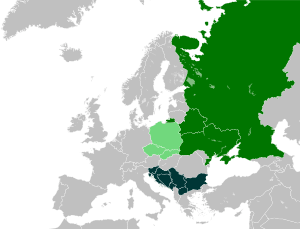Slavic languages facts for kids
Quick facts for kids Slavic |
|
|---|---|
| Ethnicity: | Slavs |
| Geographic distribution: |
Throughout Central Europe, Eastern Europe and Russia |
| Linguistic classification: | Indo-European
|
| Proto-language: | Proto-Slavic |
| Subdivisions: |
East Slavic
South Slavic
West Slavic
|
| ISO 639-2 and 639-5: | sla |
 Countries where an East Slavic language is the national language
Countries where a West Slavic language is the national language Countries where a South Slavic language is the national language |
|
The Slavic languages are a large group of languages. They are part of the even bigger Indo-European language family. People speak Slavic languages in many parts of Central Europe, Eastern Europe, the Balkans, and northern Asia.
These languages are spoken by Slavs, a large group of people who share a similar culture and history. There are many different Slavic languages, but they all come from a common ancestor language. This ancient language is called Proto-Slavic.
Contents
Exploring Slavic Languages
Slavic languages are divided into three main groups. These groups are East Slavic, West Slavic, and South Slavic. Each group has its own unique features. However, they also share many similarities.
East Slavic Languages
The East Slavic languages are mostly spoken in Eastern Europe. These languages usually use the Cyrillic alphabet for writing. This alphabet looks different from the one we use in English.
West Slavic Languages
West Slavic languages are spoken in Central Europe. Unlike East Slavic languages, these languages are usually written using the Roman alphabet. This is the same alphabet used for English.
- Czech-Slovak languages
- Lechitic languages
- Sorbian
- Upper Sorbian
- Lower Sorbian
South Slavic Languages
South Slavic languages are spoken in the Balkan region of Europe. This group also has different branches.
- Eastern
- Western
- Serbian
- Montenegrin
- Bosnian
- Croatian
- Burgenland Croatian
- Molise Croatian
- Bunjevac Croatian
- Slovenian
- Serbian
Pan-Slavic Languages
A Pan-Slavic language is a special kind of language. It is created to be understood by speakers of all Slavic languages. It helps people from different Slavic countries communicate easily.
Images for kids
-
Baška tablet, 11th century, Krk, Croatia.
-
14th-century Novgorodian children were literate enough to send each other letters written on birch bark.
-
10th–11th century Codex Zographensis, canonical monument of Old Church Slavonic
-
Map of all areas where the Russian language is the language spoken by the majority of the population.
See also
 In Spanish: Lenguas eslavas para niños
In Spanish: Lenguas eslavas para niños








